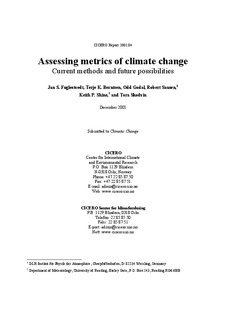| dc.description.abstract | With the principle of comprehensiveness embedded in the UN Framework Convention on Climate Change (Art. 3), a multi-gas abatement strategy with emphasis also on non-CO2 greenhouse gases as targets for reduction and control measures has been adopted in the international climate regime. In the Kyoto Protocol, the comprehensive approach is made operative as the “aggregate anthropogenic carbon dioxide equivalent emissions” of six specified greenhouse gases or groups of gases (Art. 3). With this operationalisation, the emissions of a set of greenhouse gases with very different atmospheric lifetimes and radiative properties are transformed into one common unit – “CO2 equivalents”. This transformation is based on the Global Warming Potential (GWP) index, which in turn is based on the concept of radiative forcing. The GWP metric and its application in policy making has been debated, and several other alternative concepts have been suggested. In this paper, we review existing and alternative metrics of climate change, with particular emphasis on radiative forcing and GWPs, in terms of their scientific performance. This assessment focuses on questions such as the climate impact (end point) against which gases are weighted; the extent to which and how temporality is included, both with regard to emission control and with regard to climate impact; how cost issues are dealt with; and the sensitivity of the metrics to various assumptions. It is concluded that the radiative forcing concept is a robust and useful metric of the potential climatic impact of various agents and that there are prospects for improvement by weighing different forcings according to their effectiveness. We also find that although the GWP concept is associated with serious shortcomings, it retains advantages over any of the proposed alternatives in terms of political feasibility. Alternative metrics, however, make a significant contribution to addressing important issues, and this contribution should be taken into account in the further development of refined metrics of climate change. | nb_NO |
